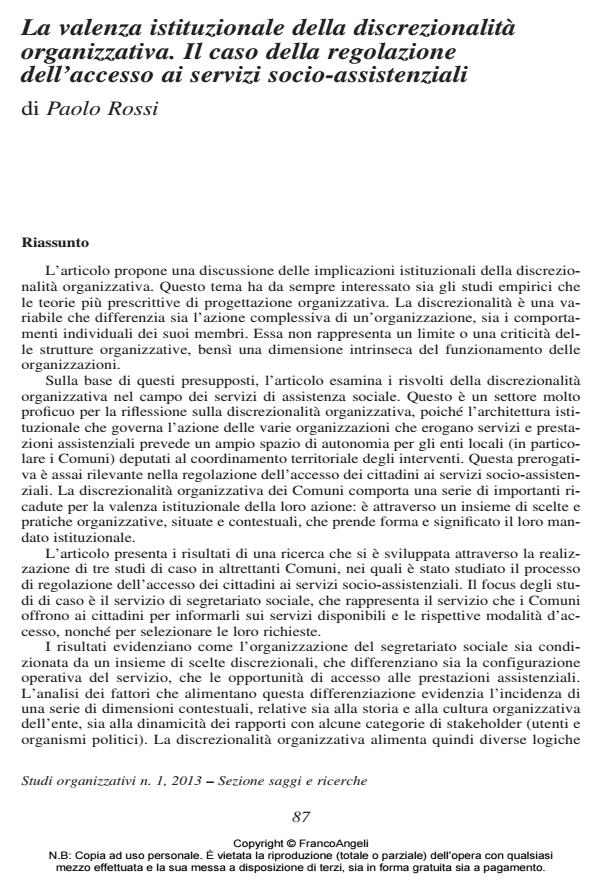Institutional implications of organizational discretion. The case of social assistance
Journal title STUDI ORGANIZZATIVI
Author/s Paolo Rossi
Publishing Year 2013 Issue 2013/1
Language Italian Pages 26 P. 87-112 File size 524 KB
DOI 10.3280/SO2013-001004
DOI is like a bar code for intellectual property: to have more infomation
click here
Below, you can see the article first page
If you want to buy this article in PDF format, you can do it, following the instructions to buy download credits

FrancoAngeli is member of Publishers International Linking Association, Inc (PILA), a not-for-profit association which run the CrossRef service enabling links to and from online scholarly content.
The article proposes a discussion of institutional implications of organizational discretion. This topic has been the subject of a number of empirical studies and the focus of prescriptive theories of organizational design as well. Discretion is a variable which accounts for the differentiation of both the overall action of an organization and the behaviour of its members. It represents neither a limitation nor an inadequacy of organizational structures, but an intrinsic dimension of organizing processes. On these bases, the article analyses the implications of organizational discretion in the sector of social assistance. This sector offers many opportunities for the study of organizational discretion. The institutional arrangement of governance of social assistance policies allows a great autonomy for those organizations (especially Municipalities) who hold the responsibility for the local coordination of the delivery of social services. The implications of this decentralization are particularly relevant in the assessment of the eligibility of applicants for social services. The discretionary power of Municipalities affects the institutional dimension of their action: their institutional mission is shaped both in its form and meaning by the effects of situated organizational practices and decisions. The article presents the findings of an empirical research made of three case studies, conducted in three different Municipalities, focussed on the analysis of the local regulation of the access of citizens to social services. The service of social secretariat, provided by Municipalities in order to inform citizens about social services they are entitled to and select individual applications, has been the focal point of the study. The findings point out the incidence of organizational discretion in the configuration of the service of social secretariat. Organizational discretion produces differentiation in the realization of the service and this brings about a subsequent differentiation of options and opportunities of access to social services. The analysis of organizational discretion in the three cases stresses the relevance of contextual factors, related to the history and the organizational culture of each Municipality and the interplay with some categories of stakeholders (users and political representatives firstly). Organizational discretion is thus the source of different institutional and organizational logics of action in the regulation of the access to social services: in the first case, the Municipality aims at promoting and broadening the options of access; in the second case, the Municipality emphasizes the control of demand in order to prioritize most urgent situations; in the third case, the Municipality is involved in the reorganization of the social secretariat, in order to provide a more professional service to citizens.
Keywords: Organizational discretion, access to services, social secretariat.
Paolo Rossi, La valenza istituzionale della discrezionalità organizzativa. Il caso della regolazione dell’accesso ai servizi socio-assistenziali in "STUDI ORGANIZZATIVI " 1/2013, pp 87-112, DOI: 10.3280/SO2013-001004